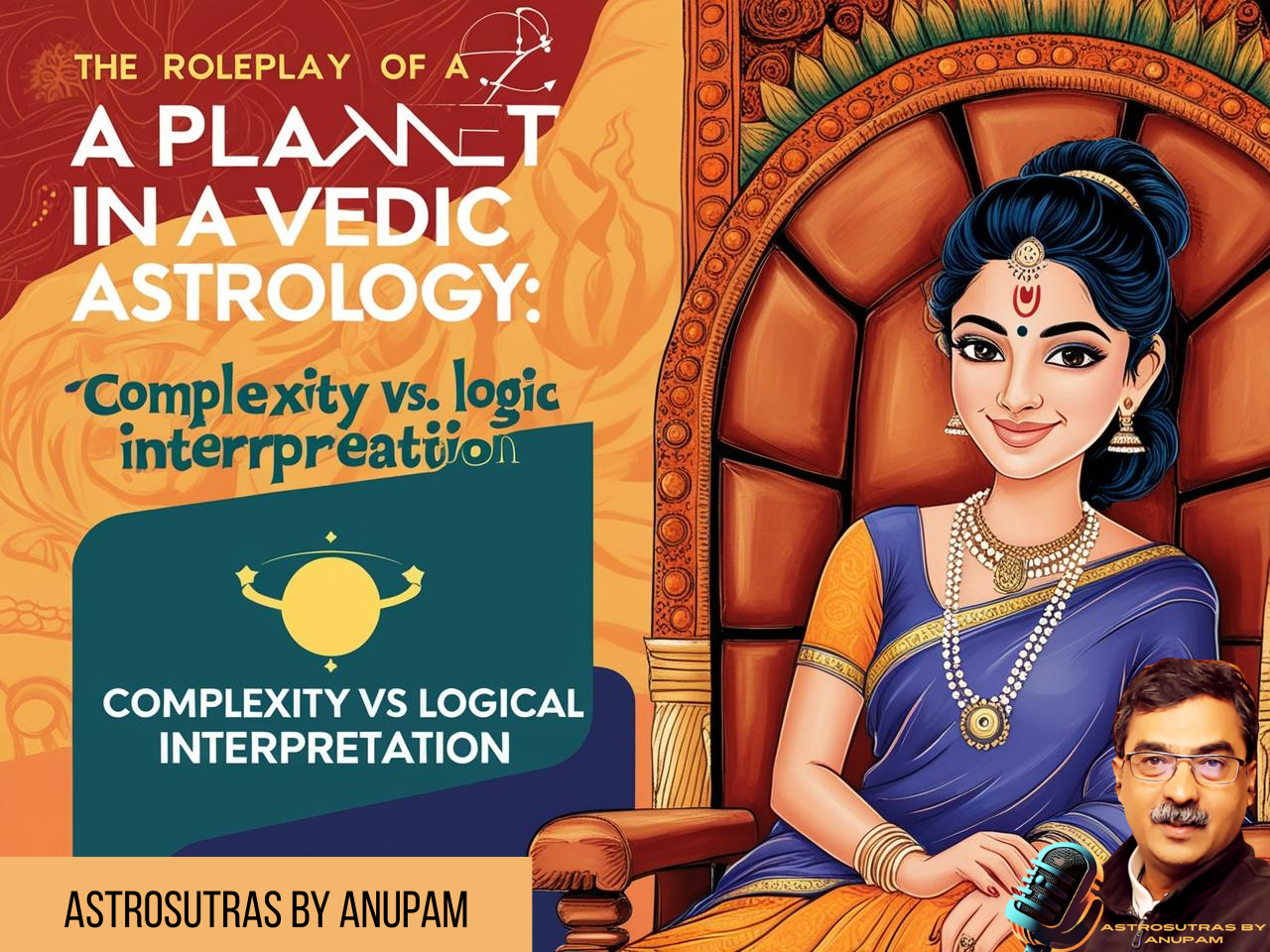The Roleplay of a Planet in Vedic Astrology: A Complex Algorithm vs Logical Interpretation

In the majestic framework of Vedic astrology, the horoscope or birth chart—known as the Janma Kundali—is a divine code composed of twelve houses (bhavas), twelve zodiac signs (rashis), and nine primary planetary entities (grahas). Each component represents specific domains, energies, and patterns, and together, they form the cosmic language through which a native’s life story is told. While this structure may appear classical and seemingly simple at first glance, the moment we start decoding the true roleplay of a planet, we realize the system is a complex algorithm that demands careful, logical, and layered interpretation.
Let us navigate through this complexity, point by point..
Let us now break this down in its deepest layers.
1. Classical Role: Natural Karakatvas and Rulership of Signs
Each planet has natural significations (Naisargik Karakatva):
- Sun: Soul, authority, father
- Moon: Mind, mother, emotions
- Mars: Energy, courage, siblings
- Mercury: Intellect, speech, trade
- Jupiter: Wisdom, wealth, children, dharma
- Venus: Love, spouse, luxuries
- Saturn: Karma, delay, discipline
- Rahu: Ambition, illusion, foreign elements
- Ketu: Moksha, detachment, past karma
Additionally, they own specific signs. This is their rulership, and it defines where their influence is spread in the chart.
At this classical stage, things are straightforward.
2. The Ascendant Filter: Functional Nature
The ascendant (Lagna) acts as the pivot for personalizing the chart. Based on the lagna, the same planet rules different houses and hence, takes on different functions.
For example:
- Jupiter is naturally benefic, but for Taurus ascendant, it rules the 8th and 11th houses—both houses are associated with challenges and materialism. Hence, it becomes a functional malefic.
- Mars, usually aggressive, becomes a yogakaraka (highly beneficial) for Cancer and Leo lagnas because of its ownership of trikona and kendra houses.
Thus, the context of ascendant modifies the basic nature of each planet. A planet’s functional role depends not only on its inherent nature but on which houses it owns in a given chart.
3. Positional Strength & Dignity: Where the Planet Resides
A planet’s placement in a house brings another layer of complexity. Here, we check:
- Is it in exaltation, debilitation, or own sign?
- Is it placed in a friendly, neutral, or hostile sign?
- Which house is it in – is it supporting dharma (1st, 9th) or obstacles (6th, 8th, 12th)?
This determines the dignity or strength of the planet. For instance:
- Mars in Capricorn is exalted—shows disciplined courage.
- Mars in Cancer is debilitated—can indicate emotional volatility.
Now, a conflict arises: what if a functionally benefic planet is debilitated? Or a malefic is exalted? The interpreter must carefully weigh functional nature vs dignity to derive a logical inference.
4. Auxiliary Systems: Divisional Charts, Avasthas, Ashtakavarga
To assess specific areas of life, we turn to Vargas (divisional charts):
- D-9 (Navamsha): Marital/spiritual strength
- D-10 (Dasamsha): Career
- D-7 (Saptamsha): Children
If a planet appears strong in the Rashi chart but weak or afflicted in D-9, its potential may not manifest fruitfully. Similarly, Ashtakavarga shows how much strength a planet holds in specific signs. Avasthas indicate mental or situational states—e.g., Lajjita (ashamed), Shanta (peaceful), etc.
Here, another question arises:
“Should we interpret the planet directly, or analyze its dispositor?”
E.g., if Mars is debilitated in Cancer, we must study Moon as its dispositor. If Moon is exalted, Mars’s affliction is somewhat neutralized. Now, a chain of interpretation begins, making it recursive.
5. Sambandhas: Planetary Relationships and Interactions
Planets do not operate in isolation. They:
- Conjoin others
- Aspect others
- Reside in nakshatras owned by others
- Share dispositor links
These create sambandhas or interplanetary relationships. For example:
- Saturn conjunct Moon in 4th house creates emotional suppression (Shasha-Chandra Yoga).
- Mars aspecting Mercury can make speech harsh but technically skilled.
These connections often override simple karakatva, requiring the astrologer to map the web of influences carefully.
6. Prioritization Puzzle: What Factor Is Dominant?
In such complexity, which parameter carries more weight?
- House ownership?
- House placement?
- Dignity?
- Aspects?
- Varga strength?
The truth is: All are essential, but not equally relevant in every context. The art of astrology lies in:
- Prioritizing what’s most relevant to the query or event.
- Layering one parameter over another in a logical sequence.
7. Confusion for Beginners: The Novice’s Trap
Beginners often jump from one concept to another without a structured flow. This results in:
- Contradictory interpretations
- Over-reliance on software outputs
- Frustration with accuracy
Hence, it’s critical to master core principles first, and build a step-by-step approach to reading a chart.
8. Dasha System: Timing and Triggering of Results
A planet may promise results, but when it delivers them is decided by the Dasha (planetary period).
In the Dasha of a planet:
- Its own strength
- Its dispositor’s condition
- Its associations all come into play.
Moreover, sub-periods (Antar-Dasha, Pratyantar-Dasha) add finer timing. A weak Jupiter in D-9 during its Dasha may delay or diminish positive results—even if it looks good in the Rashi chart.
Hence, timing requires tracing layers of connection across charts and houses.
9. Inter-House Dependencies: The Seed and Soil Analogy
Every result arises from a house—marriage (7th), career (10th), etc. But that house is:
- Strengthened or weakened by other houses (like 2nd for family values, or 11th for fulfillment)
- Influenced by the lord of that house
- Evaluated through Bhava Bal, Shad Bal, Ishta-Kashta Phala
So, the 7th house may show marriage, but unless the 7th lord is strong, and planets involved support the house, the event may be delayed, denied, or altered.
This further deepens the complexity of the planet’s role in that result.
10. Transit: Final Activation Layer
Even if the potential and timing are right, an event may not occur unless supported by transits (Gochara).
The transiting planet must:
- Be well-placed (dignity)
- Activate the house or planet related to the event
- Sometimes, trigger karmic points (like Saturn over natal Moon = Sade Sati)
But again, we ask:
Is the transiting planet giving results by its own nature, or through the house it activates?
This shows that transits do not work independently. They must be analyzed in combination with natal promise and Dasha timing.
Final Reflection: Astrology as a Multi-Layered Logic Web
The roleplay of a planet in Vedic astrology is a deep, recursive logic system. Each planet:
- Has a natural role
- Gets redefined by ownership
- Modified by placement and dignity
- Interacts with other planets
- Plays a dynamic role in Dasha
- Triggers specific karma in transit
Thus, the same planet can give completely different results in different charts and time periods.
Only by systematic learning from classical texts, and through live chart application, can one crack the code of planetary roleplay. Logical sequencing, rather than blind memorization, leads to true mastery

